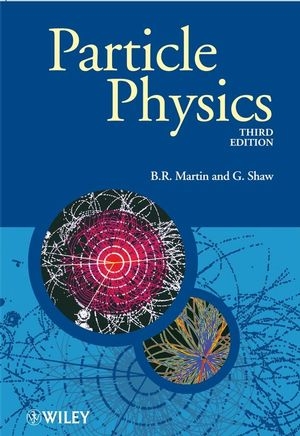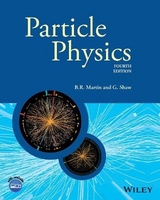
Particle Physics
Wiley-Blackwell (Verlag)
978-0-470-03294-7 (ISBN)
- Titel erscheint in neuer Auflage
- Artikel merken
An essential introduction to particle physics, with coverage ranging from the basics through to the very latest developments, in an accessible and carefully structured text. Particle Physics: Third Edition is a revision of a highly regarded introduction to particle physics. In its two previous editions this book has proved to be an accessible and balanced introduction to modern particle physics, suitable for those students needed a more comprehensive introduction to the subject than provided by the 'compendium' style physics books. In the Third Edition the standard model of particle physics is carefully developed whilst unnecessary mathematical formalism is avoided where possible. Emphasis is placed on the interpretation of experimental data in terms of the basic properties of quarks and leptons. One of the major developments of the past decade has been the establishing of the existence of neutrino oscillations. This will have a profound effect on the plans of experimentalists. This latest edition brings the text fully up-to-date, and includes new sections on neutrino physics, as well as expanded coverage of detectors, such as the LHC detector.
End of chapter problems with a full set of hints for their solutions provided at the end of the book. An accessible and carefully structured introduction to this demanding subject. Includes more advanced material in optional 'starred' sections. Coverage of the foundations of the subject, as well as the very latest developments.
Suggested Short Course Inside Front Cover. Editors' Preface to the Manchester Physics Series. Authors' Preface. Notes. 1 SOME BASIC CONCEPTS. 1.1 Introduction. 1.2 Antiparticles. 1.3 Interactions and Feynman Diagrams. 1.4 Particle Exchange. 1.5 Units and Dimensions. PROBLEMS 1. 2 LEPTONS AND THE WEAK INTERACTION. 2.1 Lepton Multiplets and Lepton Numbers. 2.2 LeptonicWeak Interactions. 2.3 Neutrino Masses and Neutrino Mixing. PROBLEMS 2. 3 QUARKS AND HADRONS. 3.1 Quarks. 3.2 General Properties of Hadrons. 3.3 Pions and Nucleons. 3.4 Strange Particles, Charm and Bottom. 3.5 Short-Lived Hadrons. 3.6 Allowed Quantum Numbers and Exotics. PROBLEMS 3. 4 EXPERIMENTAL METHODS. 4.1 Overview. 4.2 Accelerators and Beams. 4.3 Particle Interactions with Matter. 4.4 Particle Detectors. 4.5 Detector Systems and Experiments. PROBLEMS 4. 5 SPACE-TIME SYMMETRIES. 5.1 Translational Invariance. 5.2 Rotational Invariance. 5.3 Parity. 5.4 Charge Conjugation. 5.5 Positronium. 5.6 Time Reversal. PROBLEMS 5. 6 THE QUARK MODEL. 6.1 Isospin Symmetry. 6.2 The Lightest Hadrons. 6.3 Colour. 6.4 Charmonium and Bottomium. PROBLEMS 6. 7 QCD, JETS AND GLUONS. 7.1 Quantum Chromodynamics. 7.2 Electron-Positron Annihilation. 7.3 Elastic Electron Scattering: The size of the proton. 7.4 Inelastic Electron and Muon Scattering. 7.5 Inelastic Neutrino Scattering. PROBLEMS 7. 8 WEAK INTERACTIONS: QUARKS AND LEPTONS. 8.1 Charged Current Reactions. 8.2 The Third Generation. PROBLEMS 8. 9 WEAK INTERACTIONS: ELECTROWEAK UNIFICATION. 9.1 Neutral Currents and the Unified Theory. 9.2 Gauge Invariance and the Higgs Boson. PROBLEMS 9. 10 DISCRETE SYMMETRIES: C, P, CP AND CPT. 10.1 P Violation, C Violation and CP Conservation. 10.2 CP Violation. 10.3 Flavour Oscillations and the CPT Theorem. 10.4 CP Violation in the Standard Model. PROBLEMS 10. 11 BEYOND THE STANDARD MODEL. 11.1 Grand Unification. 11.2 Supersymmetry. 11.3 Strings and Things. 11.4 Particle Cosmology. 11.5 Neutrino Astronomy. 11.6 Dirac or Majorana Neutrinos? PROBLEMS 11. A RELATIVISTIC KINEMATICS. A.1 The Lorentz Transformation for Energy and Momentum. A.2 The Invariant Mass. A.3 Transformation of the Scattering Angle. PROBLEMS A. B AMPLITUDES AND CROSS-SECTIONS. B.1 Rates and Cross-Sections. B.2 The Total Cross-Section. B.3 Differential Cross-Sections. B.4 The Scattering Amplitude. B.5 The Breit-Wigner Formula. PROBLEMS B. C THE ISOSPIN FORMALISM. C.1 Isospin Operators. C.2 Isospin States. C.3 Isospin Multiplets. C.4 Branching Ratios. C.5 Spin States. PROBLEMS C. D GAUGE THEORIES. D.1 Electromagnetic Interactions. D.2 Gauge Transformations. D.3 Gauge Invariance and the Photon Mass. D.4 The Gauge Principle. D.5 The Higgs Mechanism. D.6 Quantum Chromodynamics. D.7 Electroweak Interactions. PROBLEMS D. E TABLES OF PARTICLE PROPERTIES. E.1 Gauge Bosons. E.2 Leptons. E.3 Quarks. E.4 Low-lying Baryons. E.5 Low-lying Mesons. F SOLUTIONS TO PROBLEMS. References. Index. Physical Constants, Conversion Factors and Natural Units.
| Erscheint lt. Verlag | 1.12.2008 |
|---|---|
| Reihe/Serie | The Manchester Physics Series |
| Verlagsort | Hoboken |
| Sprache | englisch |
| Maße | 172 x 243 mm |
| Gewicht | 828 g |
| Themenwelt | Naturwissenschaften ► Physik / Astronomie ► Atom- / Kern- / Molekularphysik |
| Naturwissenschaften ► Physik / Astronomie ► Hochenergiephysik / Teilchenphysik | |
| ISBN-10 | 0-470-03294-4 / 0470032944 |
| ISBN-13 | 978-0-470-03294-7 / 9780470032947 |
| Zustand | Neuware |
| Informationen gemäß Produktsicherheitsverordnung (GPSR) | |
| Haben Sie eine Frage zum Produkt? |
aus dem Bereich



